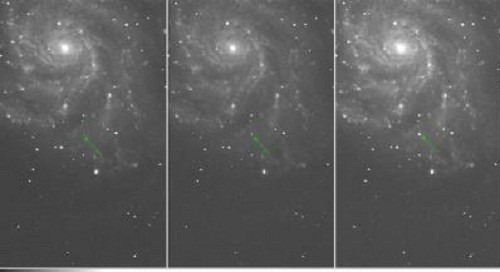Scientists Discover Shiny Supernova in Nearby Galaxy

Astronomers identified a bright, nearby supernova Wednesday in the Pinwheel Galaxy, which lies some 21 million light years from Earth and is located in the constellation of the Great Bear.
The type 1a supernova, dubbed PTF11kly, is getting brighter and could be visible with good binoculars in the next 10 days.
Supernovas are exploding stars. Type 1a supernovas are the result of a binary pair of mismatched stars, the smaller, denser one feeding on material drawn off its larger companion until it can no longer take in any more material. It then explodes in a catastrophic event that outshines the brightness of its entire galaxy, Universe Today reported.
Scientists said the supernova is the closest of its type discovered in 40 years and believe they caught it within hours of its explosion-- a rare feat for events of this type.
Scientists from the University of Oxford made the discovery with their colleagues from the Palomar Transient Factory, using a robotic telescope in California in the United States.
The most exciting thing is that this is what's known as a type 1a supernova, the kind we use to measure the expansion of the universe. Seeing one explode so close by allows us to study these events in unprecedented detail, said Oxford team leader Mark Sullivan.
“The best time to see this exploding star will be just after evening twilight in the Northern Hemisphere in a week or so's time. You'll need dark skies and a good pair of binoculars, although a small telescope would be even better,” Sullivan Said.
The scientists in PTF have discovered more than 1,000 supernovae since it started operating in 2008, but they believe this could be their most significant discovery yet. The last time a supernova of this sort occurred so close was in 1972. They are calling the latest exploding star as supernova of a generation.
Scientists around the world are scrambling to observe it with as many telescopes as possible, including the Hubble Space Telescope, and telescopes from the UC Santa Barbara-affiliated Las Cumbres Observatory Global Telescope Network.
We caught this supernova very soon after explosion. PTF 11kly is getting brighter by the minute. It's already 20 times brighter than it was yesterday, said Peter Nugent, a senior scientist at Berkeley Lab who first spotted the supernova.
The team will be watching carefully over the next few weeks, and hope to use NASA's Hubble Space Telescope to study the supernova's chemistry and physics.
Observing PTF 11kly unfold should be a wild ride. It is an instant cosmic classic, Nugent said.
Supernovas play an important role in the evolution of galaxies and planetary systems as they are the source of most of the chemical elements in the universe heavier than iron. They also seed the rest of space with elements such as carbon, oxygen and nitrogen, and can nudge gas clouds into collapsing to form new star systems.
© Copyright IBTimes 2024. All rights reserved.





















